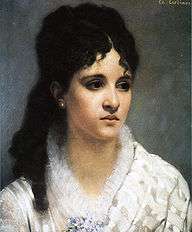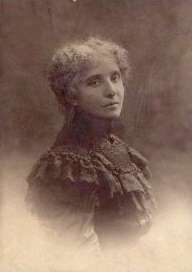Mélanie Bonis
Mélanie Hélène Bonis, known as Mel Bonis (21 January 1858 – 18 March 1937), was a prolific French late-Romantic composer. She wrote more than 300 pieces, including works for piano solo and four hands, organ pieces, chamber music, mélodies, choral music, a mass, and works for orchestra. She attended the Paris Conservatoire, where her teachers included Cesar Franck, Ernest Guiraud, and Auguste Bazille.


Life
Bonis was born to a Parisian lower-middle-class family and was educated according to the strict norms of the Catholic morality of the time. Of great talent and musical sensitivity, she taught herself the piano. Initially her parents did not encourage her music, but when she was twelve, they were persuaded by a professor at the Conservatoire to allow her to receive formal music lessons.[1] At the age of sixteen, she began her studies at the Conservatoire, and attended classes in accompaniment, harmony and composition, where she shared the benches with Claude Debussy, Gabriel Pierné, and others.[2] and received tuition from César Franck. Due to the difficulties encountered by women who wished to compose, she adopted the more androgynous form of her first name, "Mel".[3]
At the Conservatoire she met and fell in love with Amédée Landély Hettich, a student, poet and singer, setting some of his poems to music. Unfortunately, her parents disapproved of the match, and in 1883 arranged for her to marry the businessman Albert Domange, 25 years her senior (and a widower with five children from his two previous marriages), after which for a period she disappeared into domesticity and had three children. For Bonis it was not an ideal marriage as Domange did not like music.[4]
In the 1890s, she met Hettich again, who encouraged her to return to composition, after which her career took off. However, she also began an affair with Hettich, which led to the birth of an illegitimate child, Madeleine. The child was put into the care of a former chambermaid, whilst Bonis devoted all her energies to composition, becoming a member of the Société des compositeurs de musique and a published composer with Éditions Alphonse Leduc.[5]
She died in Sarcelles (Val-d'Oise).
Compositions
Chamber music
- Suite en trio, for flute, violin and piano, Op. 59 (1903)
- Fantaisie en septuor, for 2 flutes, 2 violins, viola, cello, and piano, Op. 72 (1906)
- Scènes de la forêt, for flute, horn and piano, Op. 123 (1928)
- Suite dans le style ancien, for flute, violin and piano, Op. 127 No. 1 (1928)
- Suite orientale, Op. 48
- Soir, matin, for violin and piano
- Nocturne
- Quatuor pour piano et cordes en si bémol, Op. 69
- Quatuor pour piano et cordes en ré, Op. 124
- Flute Sonata in C-sharp minor, Op. 64
- Cello Sonata in F major, Op. 67
- Violin Sonata in F sharp minor, Op. 112
- more pieces for violin and piano, flute and piano
Music for piano
Modern edition in nine volumes published by Furore:
- First volume: Femmes de légende (Legendary Women)
- Second and third volumes: Pièces pittoresques et poétiques (Picturesque and Poetic Pieces), I and II
- Fourth volume: Concert pieces
- Fifth volume: Danses et pièces légères
- Sixth volume: Piano à quatre mains A
- Seventh volume: Pièces pittoresques et poétiques III
- Eighth volume: Piano à quatre mains B
- Ninth volume: Deux pianos à quatre main, Scherzo Op. 40 and Variations Op. 85
Children's music
- Children's Scenes, Op. 92 (1912)
- Miocheries, Op. 126 (1928)
- Neuf Pièces faciles, Op. 148 (1936)
- 17 Pièces enfantines, Op. 116 (1926)
- Album pour les tout petits, Op. 103 (1913)
Organ music
- L'Œuvre pour orgue, 27 pieces, with Toccata, Cantabile, Choral, etc. (modern edition: Éditions Fortin-Armiane)
Vocal religious music
- Regina Cœli, Op. 45; Cantique de Jean Racine, Messe à la Sérénité, and many motets as Adoro te, Inviolata etc. (modern edition: Éditions Fortin-Armiane)
Orchestra
- Les Gitanos, Op. 15 No. 3 (orchestration by Ad. Gauwin)
- Suite en forme de valse
- Suite Orientale, Op. 48 (1900), includes Prélude, Op. 48 No. 1
- Bourrée, Pavane, Sarabande (1909)
- Trois Femmes de légende: Salome, Op. 100 No. 2; Ophelia, Op. 165 No. 2; The Dream of Cleopatra, Op. 180 No. 2
(modern edition: Furore)
Wind and percussions for youth
- Burlesque Symphony, Op. 185, posthumous: ballad (published by Fortin)
References
- http://www.mel-bonis.com/melboanglais.htm
- Geliot, Christine: Mel Bonis. Femme et compositeur (1858–1937), second edition (Paris: L'Harmattan, 2009), ISBN 978-2-296-09409-3.
- http://www.mel-bonis.com/melboanglais.htm
- http://www.mel-bonis.com/melboanglais.htm
- http://www.mel-bonis.com/melboanglais.htm
External links
- The website dedicated to Mel Bonis
- Biography on the site Musica et Memoria
- Biography on the site Musicologie.org
- Mélanie Bonis at Find a Grave
- Biography of Mélanie Bonis run by her descendant Contains a list of her compositions and a discography.
- Free scores by Mélanie Bonis at the International Music Score Library Project (IMSLP)